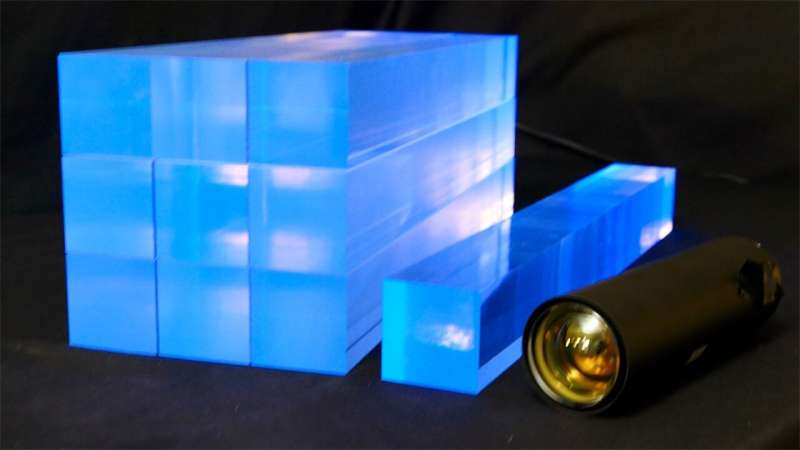
December 18, 2024 by Shelby Conn, Lawrence Livermore National Laboratory
Collected at: https://phys.org/news/2024-12-antineutrino-boost-plastic-scintillator.html
How do you find and measure nuclear particles, like antineutrinos, that travel near the speed of light?
Antineutrinos are the antimatter partner of a neutrino, one of nature’s most elusive and least understood subatomic particles. They are commonly observed near nuclear reactors, which emit copious amounts of antineutrinos, but they also are found abundantly throughout the universe as a result of Earth’s natural radioactivity, with most of them originating from the decay of potassium-40, thorium-232 and uranium-238 isotopes.
When an antineutrino collides with a proton, a positron and a neutron are produced—a process known as inverse beta decay (IBD). This event causes scintillating materials to light up, making it possible to detect these antineutrinos; and if they can be detected, they can be used to study the properties of a reactor’s core or Earth’s interior.
Researchers at Lawrence Livermore National Laboratory (LLNL), in partnership with Eljen Technology, are working on one possible detection solution—a plastic, lithium-6 doped scintillator for detecting reactor antineutrinos that represents over a decade of materials science research. Their research appears in the journal of Nuclear Instruments and Methods in Physics Research Section A: Accelerators, Spectrometers, Detectors and Associated Equipment.
Magic in plastic
In the early 2010s, LLNL materials scientist Natalia Zaitseva and her team were the first to develop a plastic scintillator capable of pulse-shape discrimination (PSD), i.e., efficiently distinguishing neutrons from gamma rays (important for detecting IBD events). Building upon this work, the new lithium-6-doped plastic scintillator formulation is also PSD-capable.
“Lithium-6 is particularly advantageous, because in addition to having a significant thermal-neutron-capture cross section, it offers a localized capture location, further enhancing the detector’s ability to effectively reject unwanted background noise,” said LLNL scientist Viacheslav “Slava” Li. This enhanced detection is made possible through the IBD process.
“While integrating lithium-6 into liquid scintillators has proven to be a challenging yet rewarding endeavor—successfully demonstrated by PROSPECT, another reactor-antineutrino experiment with fundamental LLNL contributions—achieving this in a solid, compact and easily transportable plastic scintillator has not been accomplished before, especially not at a scale suitable for effective antineutrino detection,” said Cristian Roca, LLNL scientist and corresponding author of the paper.
Compared to liquid scintillators, which have been the standard technology for reactor–antineutrino detection for decades, plastic scintillators offer superior safety and mobility with fewer of the regulatory and practicality constraints that are typically placed upon liquid scintillators and their operating environment.
Optimizing detector performance
To ready the scintillator (commercially known as EJ-299-50) for the market, researchers in LLNL’s Rare Event Detection group conducted a series of characterization measurements of the material’s performance in a large-scale detector system.
For almost six months, researchers studied the aging process of these scintillators to ensure the long-term stability of the plastic. After demonstrating the reliable optical performance and neutron identification capabilities of EJ-299-50 during this time, researchers installed 36 of the plastic scintillator “bars” in a 6 × 6 grid configuration on a detection system called the Reactor Operations Antineutrino Detection Surface Testbed Rover (ROADSTR). A follow-on study is currently underway to evaluate ROADSTR’s performance with these bars.
Alongside their scintillator work, scientists in the Rare Event Detection group are collaborating with researchers at the University of Hawai’i to improve the directional sensitivity of detectors; i.e., the ability to determine the direction of the incoming antineutrino in relation to the detector. This information can be extracted by correlating the events that take place during the IBD reaction and is especially useful in constraining the illicit production of weapons material.
The team’s research, published in Physical Review Applied and supported by the Consortium for Monitoring, Technology and Verification, explores different detector designs, finding that certain detector geometries outperform others in terms of directional resolution.
With applications in reactor safeguards and monitoring, as well as homeland security and nuclear non-proliferation, these combined research efforts are opening the door to a new era of antineutrino detection.
More information: C. Roca et al, Performance of large-scale 6Li-doped pulse-shape discriminating plastic scintillators, Nuclear Instruments and Methods in Physics Research Section A: Accelerators, Spectrometers, Detectors and Associated Equipment (2024). DOI: 10.1016/j.nima.2024.169916
Mark J. Duvall et al, Directional response of several geometries for reactor-neutrino detectors, Physical Review Applied (2024). DOI: 10.1103/PhysRevApplied.22.054030
Journal information: Physical Review Applied

Leave a Reply